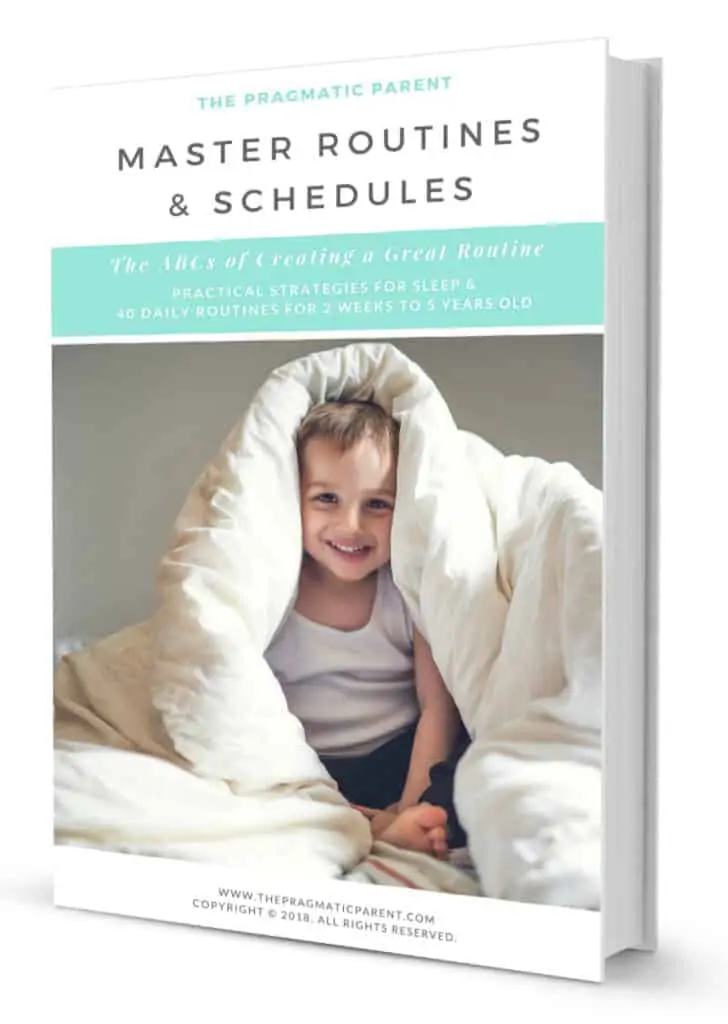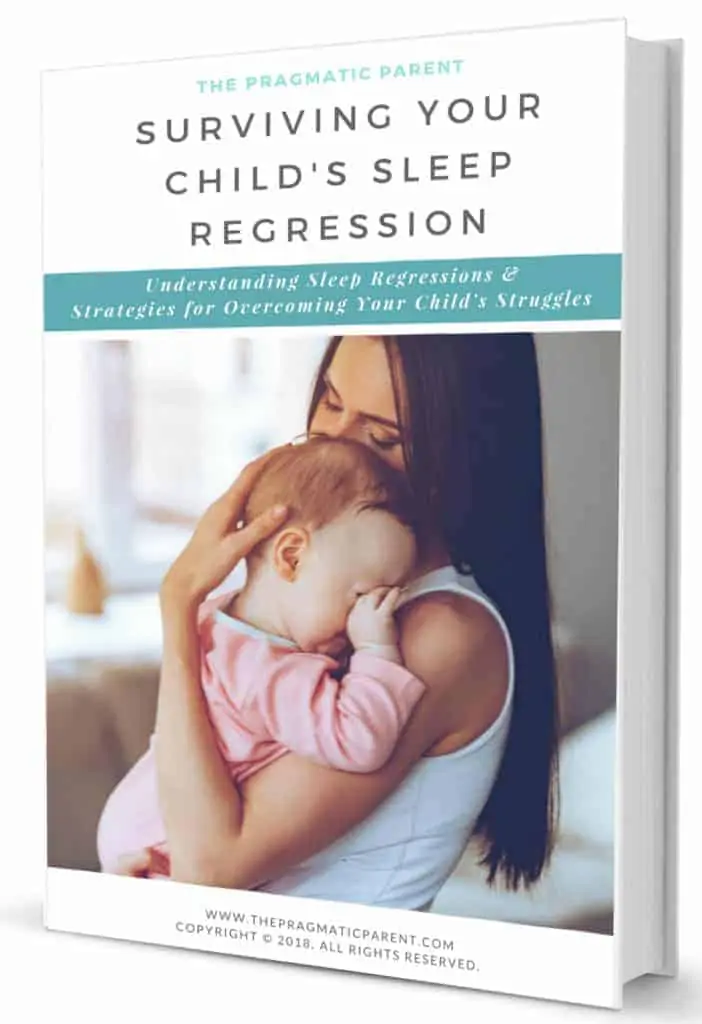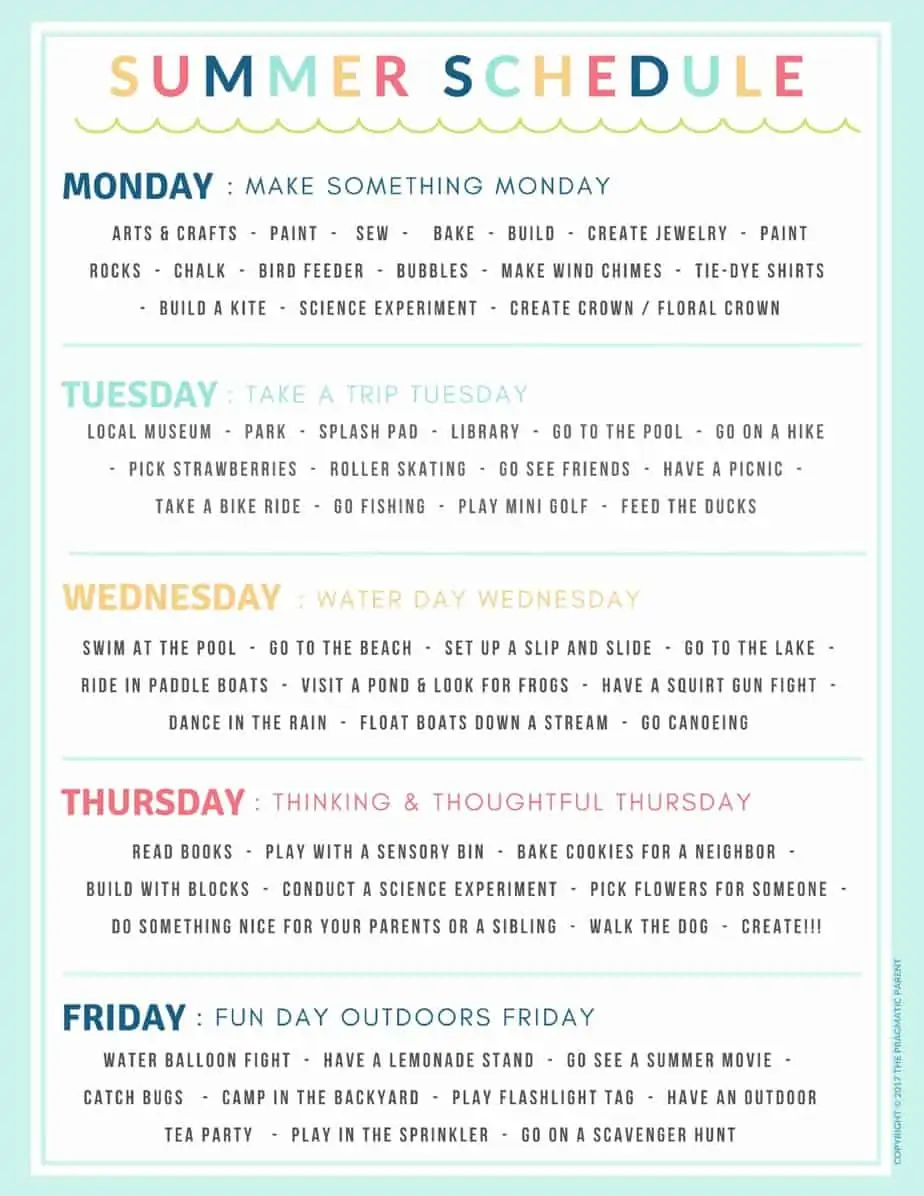The 4 month sleep regression is the first massive sleep regression stage a lot of babies will go through. Just when your baby seems to be sleeping consistently and well, sleepless nights and extra fussiness strike. Could it be the dreaded 4 month sleep regression?
If you’re in the middle of this sleep regression (the first of many unfortunately) and want to skip ahead, I put together a super helpful resource – the surviving sleep regressions ebook, a super comprehensive sleep resource to get you through this and every sleep regression your baby may hit.
There’s a collective sigh from Moms everywhere when you hear the words, “4 Month Sleep Regression.”
It’s the first massive sleep regression stage a lot of babies will go through and parents who have just gotten their baby on a solid sleep schedule and were once rejoicing in a good night’s sleep themselves (hopefully), are suddenly sleep deprived reminiscent of the newborn days and just as irritable as baby.
With three kids, I’ve been through the dreaded 4 months sleep regression once with twins at the same time and then with my third child who hit it early, and I wearily refer to as the 3 month old sleep regression.
Yep, that’s right.
Your sweet baby doesn’t have to be 4 months to hit this sleepless phase. A sleep regression in babies is unique for each little one and if they do hit it, it could be at 3 months or even into month five (i.e., 5 month sleep regression.)
Sigh.
While this is the first major sleep regression, you can learn how long it’ll last, why it happens at 4 months and sleep regression tips to get your 4 month old baby sleeping… well, like a baby again.
Plus, you’ll get sleep tools to start good sleep habits so your baby will be a good sleeper all through childhood. When you set the groundwork for good sleep habits at the 4 month mark, this can set the tone for many years to come!
If You’re in a Hurry or Looking for Quick Sleep Regression Wins…
What is the 4 Month Sleep Regression?
The 4 month sleep regression is a stage when babies struggle to get themselves back to sleep on their own once they come out of a deep sleep cycle.
This is also a time when their sleep cycle changes and causes interruptions to 4 month old sleep.
When your baby wakes from the first cycle of deep sleep, the struggle of falling into the next sleep cycle causes them to stir, cry out for your help, and that’s when your baby monitor starts squawking and waking you up throughout the night, and at nap times too.
Here are signs typical of the 4 month sleep regression:
- Baby takes longer to get to sleep.
- Your baby becomes easily startled by sounds that didn’t previously wake them, especially when they’re in the light sleep cycle.
- Baby wakes up shortly after you put them down.
- Increased night wakings and sometimes they wake up every hour in the night.
What’s Going on with My 4 Month Old Sleep Patterns?
At 4 months, your baby’s sleep is permanently changing.
Here is what’s going on.
- This is the start of a permanent change to their sleep cycle! When baby falls asleep, he’ll start with a light sleep until they slip into a deep sleep approximately 30 minutes later whereas before, they’d enter a deep sleep relatively quickly.
- Once a baby is startled out of a light sleep cycle before they hit the deep sleep cycle, of after they come out of a deep sleep cycle before they can head into the next cycle, it becomes VERY hard for them to learn how to get back to sleep (hence, why they cry out and wake up every hour in the night because they haven’t learned how to do this yet.)
The 4 month old sleep regression is difficult because it’s where your baby needs to learn a new skill with your assistance – how to put themselves back to sleep when they wake up early from a nap or bedtime.
How Long Does the 4 Month Sleep Regression Last?
The 4 month sleep regression can last just one week, or it can go on for up to 4-6 weeks. It depends on how quickly your baby can self soothe through sleep cycle transitions and get the hang of putting themselves back to sleep.
However, if there are poor sleep habits causing this first major sleep regression stage, this sleep regression can last a bit longer.
When sleep associations (rocking to sleep, nursing to sleep, holding them while they sleep, etc.) are a required aid for your baby to fall asleep, these sleep habits can affect sleep long past 4 months and well into the toddler and preschool years.
Sleep Rules for Conquering the 4 Month Sleep Regression (& Most Baby Sleep Regressions)
Before you jump to conclusions and make big changes to your daily routine, sleep schedule and sleep habits, take a deep breathe and read these sleep tips to help you through this baby sleep regression.
- Make sure the baby’s room environment is primed for optimal sleep conditions (think blackout curtains, white noise, not too cold and not too hot room temperature, not overdressed, etc.)
- Establish and be diligent about sticking to a peaceful sleep routine. Try to be home for your bedtime routine as much as you can during this sleep regression because consistency is ultra important.
- Be patient and help your baby to fall asleep on their own. Allow your baby a moment to fuss before you rush into the room. This extra time gives them an opportunity to learn how to self-soothe which is often sucking on their fingers or hands or being soothed by their surroundings.
- Don’t lean on sleep associations because they’ll come back to bite you later on. Sleep associations such as rocking to sleep, nursing to sleep, sitting by their crib and patting their back or bottom until they sleep, etc. They’re Ok to do occasionally, but when you make a habit of them, your baby will come to expect the sleep aid.
- Give them a minute to fuss and an opportunity to self sooth themselves back to sleep. If your baby is screaming, you don’t have to wait to comfort them but if they’re fussing and making a small amount of noise, sit back for a second to see what happens. Gradually you can increase the amount of fussy time you allow to see what happens as long as they’re safe and okay.
- Put your baby to sleep at the right time. Use this baby sleep chart to find the right amount of sleep between naps and nighttime sleep to make sure your baby is getting enough quality sleep.
You can also the Surviving Your Child’s Sleep Regressions Ebook for an explanation of sleep at every age and 18 survival tips to help you through the 18 month sleep regression and 2 year old sleep regression.
Navigating the Tricky 4 Month Sleep Regression…
Prime Your Baby’s Room for Optimal Sleep Conditions
Your baby spent 10 months in the womb, a dark and noisy place. With their room, you want to recreate this environment for comfort, a sense of security and familiarity.
Darken the room with blackout curtains and use a white noise machine or light fan to create the ideal environment. If the crib is near a hallway or noisy space, consider moving it to another place in the room.
It’s been shown that too warm of temperatures create more night waking. If you can, keep a cool temperature in the house but dress your baby accordingly.
Here are important tips to help your light sleeper, sleep better.
Establish & Be Diligent With Your Baby’s Bedtime Routine
Babies and young children crave the familiarity and security of routine.
A peaceful bedtime routine may start with a warm bath, lotion, diaper, pajamas, feeding in the room with the lights low or off and the noise machine on, putting him into a sleep sack and then gently rocking him for a few minutes before you place him on his back in the bed drowsy, but awake.
The key to a great bedtime routine that works is very minimal stimulation and little engagement with Mom or Dad.
Here is a suggested bedtime routine which worked well for all three of my children when they were that little.
Download Your Routine Tracker – The Starting Place for Creating a Better Routine and Great Sleep Habits
Teach Your Baby to Fall Asleep on Their Own
By putting your baby into their crib drowsy, but not sound asleep, they learn to fall asleep on their own. Once your baby learns how to do it for bedtime, they’ll do it for naptime and every time without your help.
Don’t Let Sleep Associations Turn into Poor Sleep Cruxes
Sleep associations can be anything that help your baby fall asleep and be put to bed sound asleep, instead of drowsy.
This can be anything from the bottle, nursing, pacifier, rocking to sleep, or swaddle.
You don’t want to feed or nurse your baby to sleep because drowsy is the key, and you anything that hinders them from asleep on their own can turn into a poor habit.
You don’t want their sleep cycles dependent on the crux of a bottle, breast or anything else that comforts him can turn into a long-term habit you’ll have a hard time breaking down the road.
Let Your Baby Fuss for a Minute
It’s a parent’s instinct to run to their baby at the first sound of noise, however, if your baby comes to expect you to comfort them they won’t learn to put themselves back to sleep. It’s OK to let your baby fuss for a minute or two to help them learn to put themselves back to sleep and self soothe.
Wait a few minutes to see if he calms down, and if not, go in to make sure all the basics are taken care of – wet diaper, hungry, cold, etc.
Put Your Baby to Sleep at the Right Time
You want to make sure your baby is getting the recommended number of hours of daily sleep. Set the bedtime where your baby is not overtired and has gone too long between the last nap and bedtime. An overtired baby is going to fight bedtime and sleep restlessly.
Refer to this chart for recommended sleep and awake times.
What to Do During Night Feedings or Waking
At 4-months of age, night time feedings and waking are unavoidable but when they happen, there are a few guidelines to help your baby go back to sleep quickly.
- Don’t turn on the lights. Avoid bright lights and keep things as dim as possible.
- Avoid direct eye contact
- Don’t speak or communicate with your baby unless shushing or softly humming
- Unless diapers are dirty, don’t change them & avoid waking up the baby further (go up a diaper size for nighttime to help)
- Feed your baby, and put them back to bed drowsy, but not sound asleep
The 4 month sleep regression stage (or 3 month sleep regression or 5 month sleep regression depending on when it hits) is difficult for your baby and will leave you exhausted from waking up often in the middle of the night.
Have patience, but be comforted by the fact that your baby will eventually learn how to sleep on their own with your help creating good sleep habits.
Keeping consistent sleep habits will be the biggest factor in helping your baby get a good night’s sleep.
My Favorite Tools for Good Sleep & Daily Routines for Kids:

Learn how to start creating a routine, establishing wake up and bedtimes, strategies for working through nap transitions, prepping for daylight savings time to keep your routine on track and logging your baby’s sleep patterns… all helping you rock a routine and simplify life when your days flow.
Surviving Your Child’s Sleep Regressions Ebook
Download Your Routine Tracker – The Starting Place for Creating a Better Routine and Great Sleep Habits
More Help for Sleep Regressions:
- Expert Tips to Surviving the 8 Month Sleep Regression
- Signs It’s Time to Move to One Nap a Day: How to Master the Nap Transition
- Scared of the Dark: How to Conquer Nighttime Fears
- Making the Transition to a Big Kid Bed
- How to Ease Separation Anxiety in Babies, Toddlers & Preschoolers
- 8 Common Toddler Sleep Problems & How to Handle Them
- 7 Ways to Beat Bedtime Stalling with Young Kids
- Is Your Kid Waking Up Too Early? How to Fix It
- 10 Helpful Ways to Calm the Kid Who Fights Bedtime
- Toddler Sleep Regressions: What You Need to Know About Your Two Year Old’s Sleep
- How to Establish a Peaceful Bedtime Routine for Your Baby
- How to Survive the 18 Month Sleep Regression & 2 Year Sleep Regressions
- Comprehensive Sleep Charts & Sleep Guidelines for Infants Through Adolescents
- The Benefits of Having a Daily Routine
- Create an Awesome Routine for Better Sleep Habits
Want even more?
Shop All Parenting Resources
Shop all of our parenting resources from self-regulation tools and managing big emotions to building self esteem and confidence. There are resources for all seasons of life!







